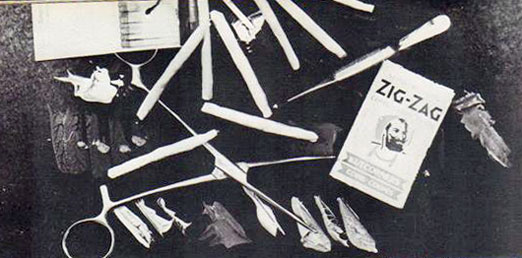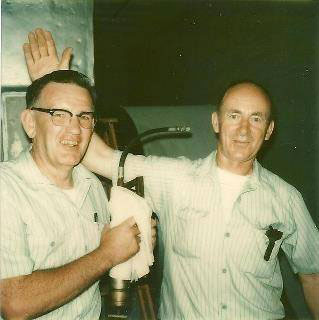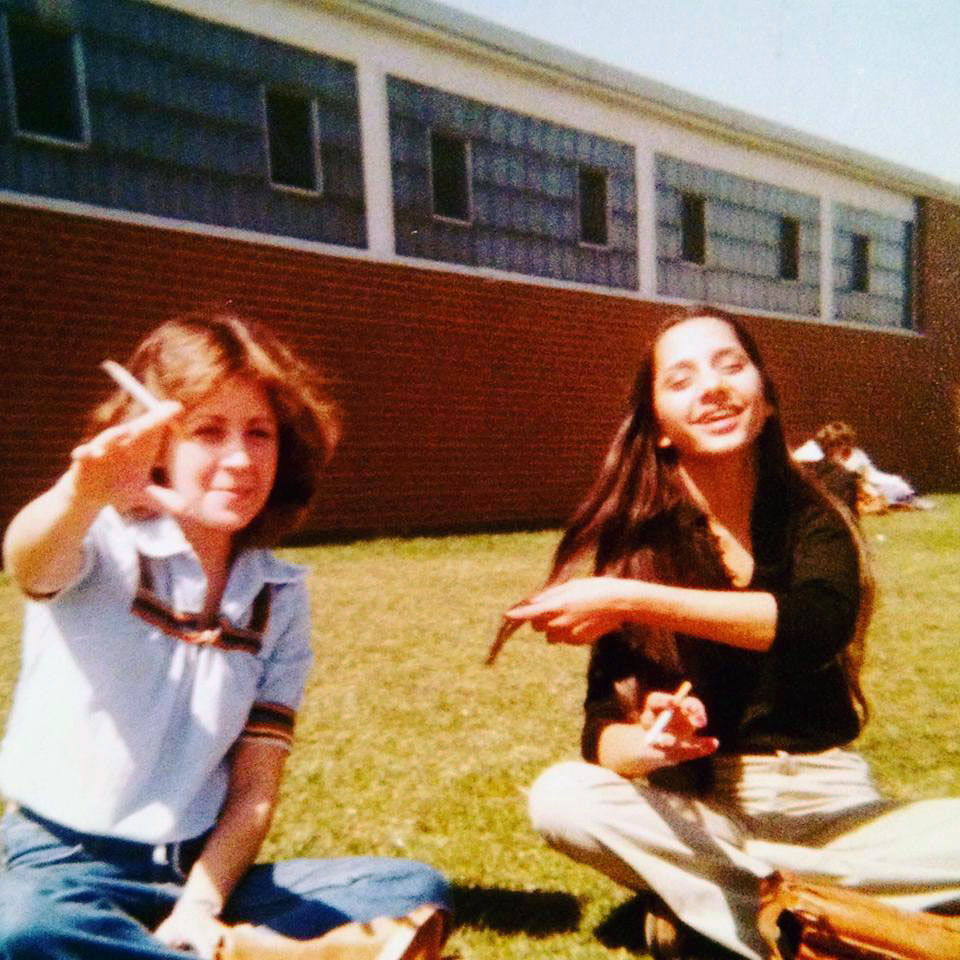Through the years, Park High students went from sneaking cigarettes at Reiss’s to having a school-sanctioned in-house smoking bathroom. The issue was white-hot for many years, until cooler head prevailed and smoking was banned from school once again. Here are some pertinent items from the Echo:
January 1969: Because of vandalism and smoking, most lavatories were locked at various times of the day. Teachers were asked to keep a closer watch on them and they were reopened.
February 1970: In an effort to curb smoking in the boys’ bathrooms, one was locked and another had its door removed and the light switch covered. Meetings were held with students and administrators to gather student suggestions about smoking, vandalism, and eating in the lavatories, and as a result, they were reopened with the promise that vandalism would stop. Assistant Principal Richard Wanio stated that if the bad behavior did not stop, guards would be hired at a cost of $10,000 per year. In that same issue, the editorial read “Misuse of lavatories must come to a halt” and spoke of a “long-dreamed-of student smoking lounge.”
ANITA
Anita Silbert became.. hall monitor? school matrol? mother to us all? in 1971. She cruised the halls of Park High for over 30 years, not only trying singlehandedly to fight the smoking fight (a losing battle), but “befriending students who were most in need of love, understanding and common sense.” Anita has an uncanny knack for remembering faces, and could spot a non-student troublemaker from 30 paces. By 1977 Assistant Principal Wanio was calling her “an institution within an institution.” When she and Jon Chambers were hired to reduce vandalism and smoking, however, the move was opposed by the student council. When she died in March 2014, her obituary revealed that she “was a proud resident of North Minneapolis’ Jewish community and an accomplished athlete at North High School. As a working mother she went on to a successful career in the women’s fashion business. Later in life despite deep, personal losses, she helped brighten the day for thousands in a 30-year career at St. Louis Park High School.”
From the November 9, 1972 Echo:
When Ms. Anita Silbert first came to Park to start her job as “school matron,” Andrew Droen, assistant principal, said to her that her first duty would be to go down to the foyer and stop the students from smoking in that area.
“There were sixty or seventy students down there,” recalls Ms. Silbert, “and I thought I could never control this. I walked up to a group of students, told them who I was and what my job was and asked them if they would please stop smoking. From then on, everything I did was like going uphill.”
Editorial in the May 2, 1973 Echo:
Repealing of smoking law supported
Attempts to stop smoking by the use of lavatory patrols have been met with “limited success.”
To help alleviate this widespread problem, two Alexander Ramsey High School students.. are lobbying for a change in the state smoking law.
This proposed change would repeal the law that prohibits the use of tobacco by those under age 18 and provides penalties of “imprisonment for not more than 30 days” or “payment of a fine of not more than $50.”
We strongly urge support for this bill … We also encourage the School Cabinet to pass a resolution favoring this and to send the resolution to State Senator Robert Lewis.
In repealing the smoking law, our purpose is not to encourage smoking. It is to allow schools to set up smoking lounges for students, instead of ruining the lavatories. Hopefully this would also isolate smokers rather tan have them all over the building, where a fire hazard might exist.
State Senator George Pillsbury, chief author of the bill, with support from several student councils throughout the state, expects the bill to be introduced before the Senate within the next week.
An Echo article from November 21, 1973 compares the smoking problems of other schools. The article starts out with a quote from Principal Bertil Johnson, who said “smoking is a ‘dilemma’ with no foreseeable permanent solution.” If a Park High student is caught smoking, they can either contribute $5 to the American Cancer Society, choose a three-day suspension, or enroll in a course on smoking. Edina had tougher rules: on the first offense a student was suspended, on the second the student’s parents were called in for a conference and the student had to go to a smoking clinic, and on the third offense the student was withdrawn from school.
December 1973: Retired policeman Arthur Barry was hired to assist Anita Silbert in patrolling the hallways and bathrooms, although his main responsibility was the parking lot. “You can’t stop kids from smoking, the best idea would be to set up a smoking lounge but now it’s still illegal,” he commented. He didn’t mind smoking but didn’t like drugs, noting that he hadn’t smelled pot in the boys’ room.
October 7, 1974 was Minnesota’s first D-Day (Don’t Smoke Day). The movement was started by Lynn Smith, publisher of the Monticello Times, who organized a non-smoking day for his community. The American Cancer Society contacted him and asked him to organize a statewide campaign.
December 1974: The Echo canvassed other schools to find that some had designated smoking areas, inside or outside the school. As for Park, “smokers have demonstrated their ‘power’ by taking over two lavatories. State law spells it out to the administrators – they are responsible for violations of the law within the school.” In an editorial, the Echo opined “We feel smoking within the school building should be punishable” and suggested that Park institute an outdoor, fenced-off area between the main building and the circle.
Smoking Lounges were set up in the first floor bathrooms by Principal Andrew Droen (1975-77) despite an ordinance that outlawed them.
“Anita actually gave us a can to put our butts in and a broom and dustpan for the bathroom where we smoked just so we would keep it clean! Circle bathroom, ground floor was the place to be, but you could smoke in any other bathroom without fear of repercussions.”

February 1979: Smokers were confined to a second floor bathroom and notified that it would be shut down in the next school year and anyone caught smoking would get a three day suspension.
September 1979: The smoking lounge was shut down after students were skipping classes to hang out in there and were vandalizing it. Instead, the school’s administration set up a designated smoking area outside the school. An editorial bemoans the poor students who must now smoke outside in the winter. Principal Dick Wanio described the area as a “pit.”
Also in September 1979, Principal Wanio reported to the School Board that smoking and loitering in the boys’ restrooms had stopped. He had checked all of them and not found a single butt. “I also did not see one student sitting down.” The Board laughed at his jokes and praised him for his program to ban smoking. (SLP Sun, September 19, 1979)
December 1979: The non-smoking policy was “mostly working,” but the smokers were just going into the neighborhood. Principal Wanio called the situation improved “1,000 percent.”
November 20, 1980: The Echo advertised the American Cancer Society’s Great American Smokeout.
December 1980: The vandalism that went along with smoking in the bathrooms was addressed in an editorial in the Echo:
The girls’ bathrooms have no soap, are short on toilet paper and paper toweling , have missing locks on most of the doors, are filled with vulgar graffiti and constantly have toilets overflowing.
As crude as this description may sound, it isn’t comparable to the appalling condition of the boys’ bathrooms. In addition to all of the above mentioned inadequacies, the boys’ bathrooms have no doors at all, no toilet paper and not only no paper toweling or soap, but often no sinks at all.
When asked why the bathroom conditions are so awful, Janitor Clarence Hickman explained that vandals are to blame.
“There are a few kids that continuously vandalize the bathrooms. We’ve put in new sinks several times, and each time they’ve come and ripped them out. Also, every morning we stock the boys’ bathrooms with toilet paper and almost right away, the vandals come and rip it out,” said Hickman. …
What the vandals are gaining by ripping apart bathrooms and what they’re doing with all that toilet paper is very puzzling, but it is definitely up to us – the students – to see that it is stopped so that everyone can answer the call of nature in a suitable atmosphere.

Custodians Dick Robe, head of custodians and Jerry Crawford at SLP high schools 1970s; the guys who cleaned up the mess! Photo courtesy Tom Mueller

September 1981: School officials, students, police, and parents had finally had enough, and smoking was banned from school grounds. In addition, police were stationed across the railroad tracks and at McDonald’s to give underage smokers tickets. Twelve students were suspended for smoking on school grounds during the first month of the school year. In addition, truancy was enforced and students skipping classes found themselves in detention. The September 30 Sun reported that students were still found congregating outside the school – in one instance throwing rocks at an elderly pedestrian – but police were called.
CHANGING TOBACCO SALES AGE TO 21
In 2017, the City of Edina led the charge to move the legal age to buy cigarettes to 21. St. Louis Park is in the process of following suit, with an ordinance that would become effective on October 1, 2017. The issue was initiated by Councilmember Sue Sanger,
because it is so well documented that people are more likiely to develop a smoking habit if they start as teenagers. Smoking contributes significantly to many health issues, both for the smoker and those around them. Raising the minimum age to purchase tobacco to 21 is a very sensible and easy-to-enforce way to address this serious public health issue.
Comments were made at the council meeting by Matt Flory of the American Cancer Society, president-elect of the Minnesota Public Health Association, and a resident who lives three houses away from St. Louis Park High School. He noted that students come to the corner near his home, just beyond the high school boundaries, to smoke, where younger students can see them. “Youth tobacco use is still a problem,” he said. (Sun-Sailor, July 6, 2017)

